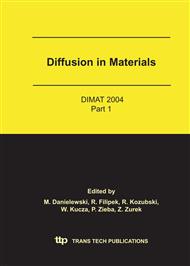p.224
p.230
p.238
p.244
p.250
p.257
p.266
p.271
p.277
Modelling of Interdiffusion and Reactions at the Boundary; Initial-Value Problem of Interdiffusion in the Open System
Abstract:
The application of the Danielewski-Holly model of interdiffusion for modelling of selective and concurrent oxidation of multi-component alloys is presented. This model enables prediction of the evolution of components distributions taking into account interdiffusion and the reactions at the boundary, e.g, due to the oxidation/sulphidation processes. The model is subsequently reformulated to the form suitable for numerical calculation. For illustrating its capabilities modelling of the selective oxidation of Ni-Pt alloys is presented. The results are compared with those obtained from Wagner model. Both models give exactly the same results for the longer reaction times. In Wagner model the equilibrium concentration of the elements at the boundary is reached instantly while in this model it changes with time. Consequently the model allows modelling of initial stages of oxidation.
Info:
Periodical:
Pages:
250-256
Citation:
Online since:
April 2005
Authors:
Keywords:
Price:
Сopyright:
© 2005 Trans Tech Publications Ltd. All Rights Reserved
Share:
Citation:


